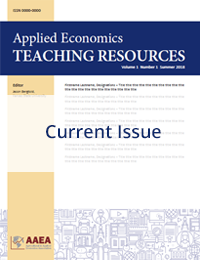Teaching and Educational Methods
Managing a Multiuse Resource with Payments for Ecosystem Services: A Classroom Game
Lauriane S. Yehouenou(a), Stephen N. Morgan(b), and Kelly A. Grogan(a)
University of Florida(a), U.S. Department of Agriculture-Economic Research Service(b)
JEL Codes: A22, Q23, Q57
Keywords: Classroom, ecosystem services, experiments, natural resource management, payments for ecosystem services
First Published Online: April 22, 2021
volume 3, Issue 3
View Full Article (PDF) | Request Teaching Notes/Supplemental Materials
Abstract
This article presents a classroom experiment that introduces students to the concept of payment for ecosystem services (PES) applied to a multipurpose renewable forest resource. Through a natural resource management game, students can analyze how PES programs may alter the individual and group harvest decisions and stocks of both components of the multipurpose resources. Participants can choose between harvesting whole trees for timber, harvesting leaves for fodder, or some combination of both. In each round, students choose the quantity of both resources to harvest for profit. Students complete the experiment with and without the PES program to enable comparison of decisions across management regimes. The outcome (usually complete forest removal) at the end of the game helps demonstrate the tragedy of the commons in the absence of conservation policies.
References
Alexander, S.J., R.J. McLain, and K.A. Blatner. 2001. “Socio-Economic Research on Non-Timber Forest Products in the Pacific Northwest.” Journal of Sustainable Forestry 13(3–4):95–103.
Bednarik, P., J. Linnerooth-Bayer, P. Magnuszewski, and U. Dieckmann. 2019. “A Game of Common-Pool Resource Management: Effects of Communication, Risky Environment and Worldviews.” Ecological Economics 156:287–292.
Climate Investment Funds. 2019, May. Contract Design in Payments for Ecosystems Services. Impact Evaluation Early Evidence Series.
Dissanayake, S.T.M., and S. Jacobson. 2019. “Money Growing on Trees: A Classroom Game about Payments for Ecosystem Services and Tropical Deforestation.” Department of Economics Working Papers 2019-09, Department of Economics, Williams College.
Farolfi, S., and K. Erdlenbruch. 2020. “A Classroom Experimental Game to Improve the Understanding of Asymmetric Common-Pool Resource Dilemmas in Irrigation Water Management.” International Review of Economics Education 35 (2020):100199.
Farley, J., and R. Costanza. 2010. “Payments for Ecosystem Services: From Local to Global.” Ecological Economics 69:2060–2068.
Food and Agriculture Organization. 2012. Voluntary Guidelines on the Responsible Governance of Tenure of Land, Fisheries and Forests in the Context of National Food Security. Rome.
Gardner, R., E. Ostrom, and J.M. Walker. 1990. “The Nature of Common-Pool Resource Problems.” Rationality and Society 2(3):335–358.
Haines-Young, R., and M. Potschin. 2010. “Ecosystem Ecology: The Links between Biodiversity, Ecosystem Services and Human Well-Being.” In D. Raffaelli and C. Frid, eds. Ecosystem Ecology: A New Synthesis. Cambridge UK: Cambridge University Press, pp. 110–139.
Handberg, Ø.N., and A. Angelsen. 2019. “Pay Little, Get Little; Pay More, Get a Little More: A Framed Forest Experiment in Tanzania.” Ecological Economics, 156, pp.454-46
Hardin, G. 1968. “The Tragedy of the Commons.” Science 162(3859):1243–1248.
Holt, C.A., C.A. Johnson, C.A. Mallow, and S.P. Sullivan. 2012. “Water Externalities: Tragedy of the Common Canal.” Southern Economic Journal 78(4):1142–1162.
Kumakawa, T. 2018. “Cooperation in a Common Pool Resource Game: Strategic Behavior and a Sense of Intimacy.” Cogent Economics & Finance 6(1):1446654.
McShane, T.O., P.D. Hirsch, T.C. Trung, A.N. Songorwa, A. Kinzig, B. Monteferri, D. Mutekanga, H. Van Thang, J.L. Dammert, M. Pulgar-Vidal, M. Welch-Devine, J.P. Brosius, P. Coppolillo, and S. O’Connor. 2011. “Hard Choices: Making Trade-Offs between Biodiversity Conservation and Human Well-Being.” Biological Conservation 144(3):966–972.
Murphy, J.J., and J-C. Cárdenas. 2004. “An Experiment on Enforcement Strategies for Managing a Local Environment Resource.”
The Journal of Economic Education 35(1):47–61.
Myers, N. 1988. “Tropical Forests: Much More Than Stocks of Wood.” Journal of Tropical Ecology 4(2):209–221.
Ngoma, H., A.T. Hailu, S. Kabwe, and A. Angelsen. 2020. “Pay, Talk, or ‘Whip’ to Conserve Forests: Framed Field Experiments in Zambia.” World Development, 128.
Ostrom, E., and H. Nagendra. 2006. “Insights on Linking Forests, Trees, and People from the Air, on the Ground, and in the Laboratory.” Proceedings of the National Academy of Sciences 103(51):19224–19231.
Secchi, S., and S. Banerjee. 2019. “A Dynamic Semester-Long Social Dilemma Game for Economic and Interdisciplinary Courses.” The Journal of Economic Education 50(1):70–85.
Simons, A., and J.L. Stewart. 1994. “Gliricidia sepium—A Multipurpose Forage Tree Legume.” In R.C. Gutteridge and H.M. Shelton, eds. Forage Tree Legumes in Tropical. Wallingford UK: Agriculture CAB International, pp. 30–48.
Wunder, S. 2005. Payments for Environmental Services: Some Nuts and Bolts (No. CIFOR Occasional Paper no. 42, p. 24p).
Articles in this issue
Teaching by the Case Method to Enhance Graduate Students Understanding and Assessment of Wicked-Type Problems: An Application Involving the Bears Ears National Monument
Amanda J. Harker Steele and John C. Bergstrom
Seeds of Learning: Uncertainty and Technology Adoption in an Ecosystem-Based Adaptation Game
Babatunde Abidoye, Sahan T.M. Dissanayake, and Sarah A. Jacobson
Managing a Multiuse Resource with Payments for Ecosystem Services: A Classroom Game
Lauriane S. Yehouenou, Stephen N. Morgan, and Kelly A. Grogan
Making Learning about Climate Change Fun and Interactive
Misti D. Sharp and Jada M. Thompson
What does the pandemic mean for experiential learning? Lessons from Latin America
Grace Melo, Dérgica Sanhueza, Sarahi Morales, and Luis Peña-Lévano
Learning about Consumer Demand from Student Surveys
Scott M. Swinton


